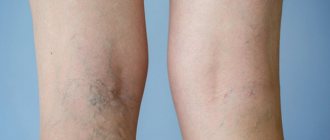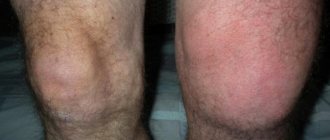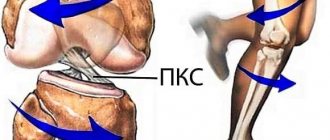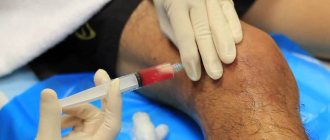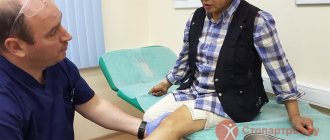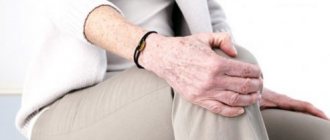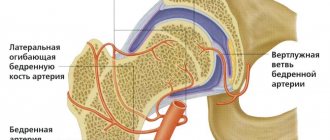- Home >
- Symptoms >
- Burning in the joints
A burning sensation in the joints (usually a burning pain) or in the skin above them occurs very often in many diseases, and not only rheumatological ones.
Sometimes it turns out that this is the first and even the only symptom, so it is worth paying attention to. What is this burning sensation anyway? This is a kind of pain syndrome that is characteristic of inflammatory processes and acute circulatory disorders. The burning sensation may appear as if inside the joint, or it may be felt on the surface, that is, on the skin. Apart from burns/frostbite and similar situations, we rarely talk about the second option. In most cases, a burning sensation is still felt inside the joint.
At the MART clinic on Vasilyevsky Island
- Experienced doctors (including those practicing in the USA and Europe)
- Prices affordable for everyone
- Expert level diagnostics (MRI, ultrasound, tests)
- Daily 8:00 — 22:00
Make an appointment
Burning knees: what is the reason?
The knees do not burn and hurt on their own; there is always a reason that causes the discomfort. But they do not appear immediately: after a bruise, for example, it may take several, or even weeks, until heat appears in the knees, and you do not understand that this is a consequence of the injury. There may be several reasons why knees burn, in addition to injuries:
- infectious diseases;
- inflammatory processes;
- increased physical activity;
- diseases of the joints or spine;
- skin diseases;
- frostbite;
- oncology.
It is important to determine from the very beginning what is causing the discomfort. If these are external factors such as bruises, frostbite, problems with the epidermis, the treatment will not last long. It is much worse when the knee burns inside, because this may indicate serious problems with the musculoskeletal system. In such cases, treatment can be lengthy, and the methods may not be the most gentle, including surgical intervention.
You shouldn’t look for the reasons why your knees become hot on your own. The best option is to seek help from a specialized specialist as soon as possible. The sooner the type of pathology is determined, the easier and more effective the treatment will be. And the greater the chance of complete restoration of joint mobility.
Primary diagnosis and assistance before visiting a doctor
Injuries, skin diseases, inflammatory processes, and frostbite are quite easy to diagnose on your own, since the signs of pathology will be obvious. In each specific case, first aid will be different. In case of bruises, it is necessary to ensure immobility of the joint by using a tight bandage and apply ice to avoid swelling. If the causes of burning and a local increase in temperature are associated with mild frostbite, you need to get into a warm room as soon as possible, and then apply a thermal insulating bandage to the problem area.
If it is unknown why the knees are burning, but the patient suffers from any dermatological diseases or allergies, first aid will consist of taking antihistamines or treating the skin in the joint area with creams against psoriasis and dermatitis. In case of inflammatory processes, when the knees are burning, and it is known for sure that this is a consequence of an infectious disease, it is necessary to urgently take antibiotics.
What to do if your knee hurts and burns due to increased physical activity? First of all, immobilize the joint and minimize activity. However, immobility is only a temporary measure, not a panacea. Moreover, complete lack of physical activity for a long period can worsen the situation.
If it is not clear why your knees turn red, but there is pain and discomfort in the knee joints, you can resort to universal remedies - ointments and tablets that will help relieve discomfort. But we must remember that this is not a treatment, but only an auxiliary measure. Only a specialized specialist can determine why your knees are burning and prescribe a course of treatment.
Traditional therapy
The main treatment is aimed at eliminating the cause of the burning sensation. At the same time, painkillers and drugs aimed at restoring normal functioning of the joint are prescribed. Most often, chondroprotectors and anti-inflammatory drugs are prescribed. Along with this, courses of massage or manual therapy, therapeutic exercises and physical education are prescribed.
If the patient has a lot of weight, he will definitely be advised to reduce it, since obese people put a lot of stress on their joints, including the knees.
It should also be understood that the treatment of pathologies associated with the fact that the legs are burning above the knees, a burning sensation is felt in the knees themselves and below, takes a long time. Even if remission occurs at some point, the course of treatment still cannot be interrupted.
As an additional treatment, a visit to the pool, mud or radon baths may be recommended.
What you need to know about diagnostics
A visit to the doctor is the most reasonable solution when your knees are burning and it’s unclear what to do. Characteristic symptoms and visual examination often make it possible to make a preliminary diagnosis and take the necessary measures to alleviate the patient’s situation. But in most cases, the doctor prescribes a comprehensive examination to determine why the discomfort appeared. In addition to tests, additional types of diagnostics may be prescribed - x-rays, ultrasound, computed tomography. In some cases, specialists from related fields are involved in the examination - oncologist, dermatologist, surgeon.
It is important to remember that a simple burning sensation in the knee may hide a serious illness. If you waste time and do not seek medical help when the first unpleasant symptoms appear, the consequences may be irreversible. If it is difficult to determine what it means when your knee pinches, you cannot risk your health; you need to undergo a full medical examination as soon as possible. After all, knee problems are usually just one of the symptoms of various diseases. The sooner they are diagnosed, the higher the likelihood of completely getting rid of the disease.
My hands are red and itchy and burning, what is it? Causes of redness of the skin of the hands
Red skin on the hands is a phenomenon that can arise from almost any reason. Here are the most common ones:
- osteochondrosis. Damage to the cervical vertebrae leads to damage to the nerve roots emerging from them. Symptoms of this disease are tingling and burning in the fingertips, especially in the middle and ring fingers;
- thermal factor. Too high or too low an ambient temperature causes redness on the hands and itching;
- allergy. Some foods - for example, honey, seafood, chocolate, citrus fruits - can trigger the development of contact dermatitis or urticaria, which manifests itself as redness on the hand;
- stroke. Burning, numbness, itching or pins and needles in the hand and fingers are one of the signals that, along with speech and vision disturbances, chest pain and nausea, portend a cerebral hemorrhage;
- carpal tunnel syndrome. Injury to the nerve endings in the wrist area may result in hand numbness or pain or malaise. One of its consequences is redness and peeling of the skin on the hands;
- Raynaud's syndrome (narrowing of blood vessels in the hand, antispasmodic attacks). This disease develops as a result of severe and prolonged stress, hypothermia, and contact with toxins. Its symptoms are numbness in the hand and wrist;
- polyneuropathy (organic damage to the nerve plexuses in the hand and wrist, resulting from previous infections, functional diseases, and lack of vitamins). This disease causes numbness, tingling or redness of the fingers;
- fungus. This is an extremely serious disease - in the early stages it causes redness on the fingers, palms and skin folds, which gradually transforms into fluid-filled blisters. At the slightest movement they burst, bleed and heal, turning into brown plaques and scars;
- eczema. Occurs with prolonged contact with household chemicals, problems with hormones, decreased immunity, hydration imbalances (excessive sweating). The disease manifests itself as redness of the skin on the fingers and between them, and then blisters, cracks, pigment spots form in place of the spots, and the skin thickens;
- scabies. Scabies mites, which cause the disease, can burrow into the skin of the fingers, wrists, palms, and other parts of the body. Their presence is determined by itching, scratching, the appearance of paired blisters, and purulent inflammation.
What and how to treat knees
Relieving burning and pain is only the first step towards restoring health. More precisely, helping the body get rid of unpleasant sensations. However, often this has nothing to do with the treatment of the disease itself. When the doctor knows that fever in the knees is a consequence of one or another pathology, a full course of treatment is prescribed, which may include:
- massage;
- physiotherapeutic procedures;
- therapeutic exercises;
- use of medications.
If we are talking about serious damage to the knee joint caused by injuries or diseases of the musculoskeletal system, surgical intervention is indicated. Most often, this is endoprosthetics - an operation in which a joint is partially or completely replaced with a prosthesis. Modern technologies make it possible, with the help of such an operation, to completely restore the mobility of the lower extremities and return patients to a full life.
Surgical intervention with prosthetics is also indicated in the case of cancer, when bones and joints are damaged as a result of metastases. Just a few decades ago, with such a diagnosis, the only way out of the situation was amputation of limbs. Today, joint replacement is a simple, effective and minimally invasive way to solve problems for people who are faced with cancer.
Cheeks are red and burning. Why do cheeks turn red when excited?
As you know, unexpected redness of the skin (which most often comes at absolutely the wrong time) occurs due to the emotional excitement that precedes it. Excitement causes expansion of the capillaries of the head, blood flow to which improves cerebral circulation. In such cases, not only the cheeks and ears, but also the neck and forehead may become very red. During any manifestation of stress, which includes anxiety, our body activates the sympathetic nervous system, which is responsible for human behavior in case of danger. Thus, the experiencer may experience increased heart rate, muscle tension, and increased activity of the sweat glands. It’s no wonder: considering this or that situation important or dangerous, our body activates all the resources available to it in order to find a solution to the problem that has arisen as soon as possible.
Most often, redness of the face occurs due to severe emotional stress or excitement.
In addition to the potential for problem solving and, more importantly, potential survival in nature, significant blood flow to the head has another original function. There is an exotic theory that evolution came up with unexpected reddening of the facial skin in order to increase the chances of the “blushing” person being liked by the interlocutor. Indeed, we are liked more ruddy than pale, due to the fact that on a subconscious level, ruddy cheeks give a signal about our health and ability to reproduce.
It is no coincidence that since ancient times girls have been using all kinds of blush and paints to imitate a natural blush.
How to protect your knees from problems
No one is immune from pain in the knee joints, but you can always take care to minimize discomfort and prevent the development of serious orthopedic diseases. Medical practice shows that problems with knees most often occur in people who spend a lot of time on their feet or constantly expose their legs to increased physical activity. If these factors are excluded, then the risk of destruction of the knee joints due to constant mechanical impact will be minimal.
Injuries are another source of knee problems. Therefore, when playing sports, you need to try to protect your joints as much as possible using modern protective equipment. For example, knee pads that minimize the consequences of bruises. However, the risk of injury is not a reason to give up riding a bike or playing hockey. It must be remembered that the lack of physical activity for the knee joints is no less harmful than overexertion. Everything should be in moderation.
Often, people who lead an active lifestyle and carefully monitor their own health still experience problems with their knees. A thorough medical examination usually shows that the cause is an unbalanced diet. Fashionable diets and avoidance of animal products, which contain macro- and microelements so necessary for joints, can cause burning in the knees. Complex preparations for strengthening joints will help correct the situation, but after a course of treatment you should completely reconsider your diet. To maintain the musculoskeletal system in good condition, you should include fresh fruits and vegetables, meat and fish in your food daily. The menu is selected in such a way that the food contains vitamins, amino acids, proteins - “building material” for bones and joints. No less important is calcium, which is washed out of the body with age, which leads to serious problems with the musculoskeletal system and can cause incurable diseases.
The knuckles are red and burning. Causes of red fingers
Red fingers and palms of the hands can be the result of various factors. Here are just a few reasons for redness:
- Atopic dermatitis.
- Allergies to medications, food, environmental factors.
- Insect bites.
- Erysipelas and other infectious diseases of a bacterial nature.
- Fungal skin lesions.
- Dyshidrotic eczema.
- Inflammation in autoimmune diseases: systemic scleroderma, dermatomyositis.
Many of these conditions are still considered quite rare. In most cases, redness and peeling of the skin occur due to atopic dermatitis and allergies.
Can water cause irritation?
Patients often associate redness of the skin of their hands with exposure to water. This is indeed possible under the following conditions:
- Weeping eczema. With this pathology, due to autoimmune disorders and pathology of the neuroendocrine system, bubbles with clear liquid appear on the hands. With increased skin moisture at the site of the lesion, they have difficulty healing and only progress. If work or household activities involve frequent washing or laundry, then it is very difficult to overcome such a disease.
- Allergy to substances contained in water. Only distilled water is considered absolutely pure, while running and spring water contains a large amount of trace elements and other substances. A person may be intolerant to any of the components of this “cocktail”. Therefore, it is likely that allergies will develop.
Skin reaction to water is often observed when a person moves. The skin has already adapted to one composition of the liquid, but serious changes in the composition cause an intolerance reaction.
Features of a child
Skin changes on the hands and wrists can occur at any age: in the newborn period, at 2 years and beyond. The following may contribute to the reaction in children:
- Allergic diseases in mother and father.
- Taking medications during pregnancy.
- Early introduction of allergenic foods into complementary feeding.
- Eating preservatives.
- Hereditary predisposition.
Redness and itching on the skin of children can also be not only allergic. Atopic dermatitis is one of the most common causes.
A child does not always notice insect bites, so this factor should not be ruled out when redness is detected.
But autoimmune diseases (dermatomyositis and systemic scleroderma) rarely occur in children, although their occurrence is also possible.
